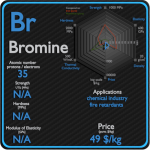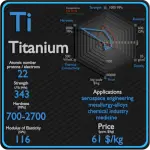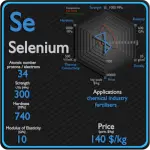This article contains comparison of key thermal and atomic properties of potassium and zinc, two comparable chemical elements from the periodic table. It also contains basic descriptions and applications of both elements. Potassium vs Zinc.

Potassium and Zinc – About Elements


Source: www.luciteria.com
Potassium and Zinc – Applications
Potassium
Potassium (K) is an essential nutrient for plant growth. It’s classified as a macronutrient because plants take up large quantities of K during their life cycle. Agricultural fertilizers consume 95% of global potassium chemical production, and about 90% of this potassium is supplied as KCl. Due to its high degree of reactivity, pure potassium is rarely used in its elemental /metallic form. It is used as a powerful reducing agent in organic chemistry. Potassium/Sodium alloys are It used as a heat exchange medium . The heat in the potassium warms water and makes it hot enough to boil. Then water is changed into steam, which is used to work devices that generate electricity.
Zinc
Corrosion-resistant zinc plating of iron (hot-dip galvanizing) is the major application for zinc. Coating of steel constitutes the largest single use of zinc, but it is used in large tonnages in zinc alloy castings, as zinc dust and oxide, and in wrought zinc products. Galvanized steel is just plain carbon steel that has been coated with a thin zinc layer. The zinc protects iron by corroding first, but zinc corrodes at much lower rates than do steel. Other applications are in electrical batteries, small non-structural castings, and alloys such as brass. A variety of zinc compounds are commonly used, such as zinc carbonate and zinc gluconate (as dietary supplements), zinc chloride (in deodorants), zinc pyrithione (anti-dandruff shampoos), zinc sulfide (in luminescent paints), and dimethylzinc or diethylzinc in the organic laboratory. A key part of the modern materials world in which zinc finds itself is recycling. Zinc, in common with all metals (and unlike synthetic materials) can be recycled indefinitely without degradation.
Potassium and Zinc – Comparison in Table
| Element | Potassium | Zinc |
| Density | 0.856 g/cm3 | 7.14 g/cm3 |
| Ultimate Tensile Strength | N/A | 90 MPa |
| Yield Strength | N/A | 75 MPa |
| Young’s Modulus of Elasticity | 3.53 GPa | 108 GPa |
| Mohs Scale | 0.4 | 2.5 |
| Brinell Hardness | 0.36 MPa | 330 MPa |
| Vickers Hardness | N/A | N/A |
| Melting Point | 63.25 °C | 419.53 °C |
| Boiling Point | 760 °C | 907 °C |
| Thermal Conductivity | 102.4 W/mK | 116 W/mK |
| Thermal Expansion Coefficient | 83 µm/mK | 30.2 µm/mK |
| Specific Heat | 0.75 J/g K | 0.39 J/g K |
| Heat of Fusion | 2.334 kJ/mol | 7.322 kJ/mol |
| Heat of Vaporization | 79.87 kJ/mol | 115.3 kJ/mol |


















